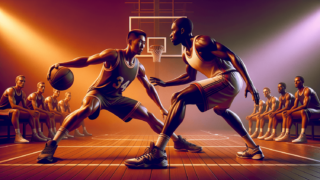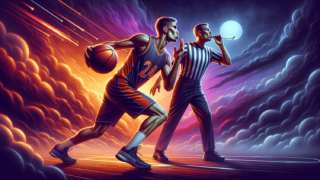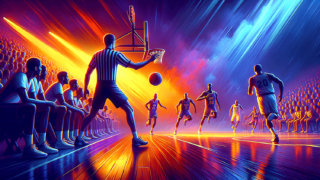
When it comes to basketball, the action on the court is often fast-paced and intense, with athletes displaying an impressive mixture of skill and passion. But amidst this flurry of excitement, there are rules and regulations that must be enforced to maintain the balance and fair play of the game – one of which is the infamous “technical foul”. In this blog post, we’ll delve into the world of technical fouls in basketball, exploring their definition, application, impact on games, and even some of the most memorable T’s in the history! Whether you’re an avid fan or a newcomer to the sport, buckle up to learn everything worth knowing about this intriguing aspect of hoops action.
What Is a Technical Foul in Basketball?
A technical foul in basketball is a penalty given for violations of conduct, unsportsmanlike behavior, or for administrative breaches of rules that do not involve player contact on the court. It helps maintain order and uphold the spirit of fair competition. A technical foul can be assessed against players, coaches, or team personnel, resulting in one free throw for the opposing team and, in certain situations, the added penalty of temporary disqualification.
Exploring the Types of Technical Fouls in Basketball
Technical fouls (also referred to as simply T’s) can be broadly categorized into three distinct types. By understanding these classifications and knowing when they are typically applied, it becomes easier to follow the ever-evolving strategic landscape of the game. Let’s explore each in depth:
Player Technical Fouls
As the name suggests, player technical fouls are those assessed directly against individual players. They can stem from a wide variety of behaviors, including but not limited to:
- Arguing with referees or showing disrespect towards their decisions
- Deliberately delaying the game, such as not throwing the ball to the referee during a dead-ball situation
- Excessive celebrations, taunting, or trash-talking that is deemed unsportsmanlike
- Excessive hanging on the rim after a dunk (unless it’s done to avoid injury)
- Violations of uniform or equipment rules, such as not wearing a jersey tucked into the shorts
Player technical fouls are typically assessed at the discretion of the referees, who must determine whether certain behaviors or actions cross the line between passion and unsportsmanlike conduct. Importantly, accumulating two player technical fouls in a single game will result in automatic ejection, making them a crucial aspect of late-game strategy and tension.
Coach and Bench Technical Fouls
Coaches and other team personnel are expected to adhere to a particular code of conduct during games, thus promoting a respectful and professional environment. Similar to player technical fouls, coach and bench technical fouls are handed out when these off-court participants engage in unsportsmanlike behavior or otherwise breach the established guidelines. Examples of such actions include:
- Complaining excessively to the referees or other game officials
- Encroaching onto the court without permission
- Entering the scorer’s table or making substitutions without following the appropriate protocols
- Displaying aggressive, hostile or overly animated behavior, particularly towards officials or opposing team members
Given the influential role coaches play in their team’s overall performance, coach and bench technical fouls can have a meaningful effect on game outcomes, emotions, and tensions. Notably, a single technical foul can also lead to a coach’s ejection, further amplifying the stakes of these infractions.
Administrative Technical Fouls
Beyond the realm of on-court or sideline conduct, basketball games also require adherence to countless administrative rules and procedures. Technical fouls can be given for myriad infractions, such as:
- Incorrectly filling out the official scorebook
- Starting a game with an illegal lineup (e.g., including players who have fouled out or been ejected)
- Failing to submit a roster or any other required documentation before tip-off
- Submitting a player for substitution who was not on the roster or who has been ejected
While administrative technical fouls might seem mundane or even trivial in comparison to their more dramatic counterparts, they nonetheless impact games by providing opposing teams with additional scoring opportunities and, in some cases, creating an environment ripe for frustration and flare-ups.
The Consequences of Technical Fouls in Basketball
Technical fouls come with a combination of penalties that can impact both the immediate outcome of games and the availability or readiness of key personnel. These consequences include:
Free Throws
Regardless of the type of technical foul assessed, one constant repercussion is the granting of one free throw to the opposing team. The player selected to take this free throw is usually a team’s best free throw shooter, and the other players must remain behind the half-court line during the attempt. As such, technical fouls can lead to direct and immediate changes in a game’s score, possibly altering the outcome entirely.
Fouls Count toward Disqualification
In addition to influencing the score, technical fouls also come with the added burden of counting towards a player’s total number of fouls in a game. In most levels of basketball, players are disqualified from the contest after receiving a certain number of fouls:
- NBA and NCAA men’s basketball: 6 fouls
- FIBA (International), NCAA women’s basketball, and high school: 5 fouls
Since each technical foul counts as one “whole” foul, a player who has been assessed a technical foul becomes more susceptible to fouling out and leaving their team short-handed.
Ejections
As mentioned previously, in many leagues, such as the NBA, a player or coach who accumulates multiple technical fouls in a single game – typically two – will be automatically ejected from the contest. Ejections not only remove a key figure from the remainder of the game but can also lead to additional suspensions, fines or other punitive measures as deemed appropriate by the league. In this way, technical fouls serve as a vehicle for promoting good sportsmanship, adherence to the rules, and a level playing field for all involved.
Famous Technical Fouls: A Trip Down Memory Lane
Technical fouls have long played a prominent role in the world of basketball, often leading to memorable moments and heated exchanges. Let’s take a step back in time and revisit some of the most iconic technical foul incidents in history:
Rasheed Wallace’s NBA Record
Portland Trail Blazers and Detroit Pistons power forward Rasheed Wallace had a career that was as storied for his gritty play as it was for his frequent clashes with referees. During the 2000-2001 NBA season, Wallace set a then-NBA record by picking up 38 technical fouls over the course of 77 games, a pace that left him serving multiple league-mandated suspensions for his hot-headed antics.
The Celtics-Lakers Rivalry Heats Up
As two of the NBA’s most storied franchises, the Boston Celtics and Los Angeles Lakers have a rivalry that stretches back decades. One of the defining moments in their storied competition came during the 1984 NBA Finals, when Celtics forward Kevin McHale delivered a hard clothesline foul on Lakers forward Kurt Rambis, leading to several technical fouls and the ejection of both players. This incident only served to heighten tensions between the teams and fans alike, and remains a touchstone of the intense rivalry.
The “Malice at the Palace”
No discussion of technical fouls would be complete without mentioning the infamous “Malice at the Palace.” This massive brawl erupted during a 2004 game between the Detroit Pistons and the Indiana Pacers – and spilled into the stands, involving fans as well. Multiple players received technical fouls, and nine players were given suspensions totaling 146 games, making it one of the most severe incidents in basketball history, with deep-rooted consequences for both teams.
Using Technical Fouls to Your Advantage: Coaching Perspectives
While technical fouls often carry negative connotations, savvy coaches can occasionally use them to their advantage, leveraging them to shift momentum, inspire their team, or protect their players. By drawing the ire of the referees via a technical foul, coaches can send a clear message to their team that they have their back – and this can energize and galvanize players in crucial moments of the game.
To use technical fouls in this manner, it’s essential for coaches to avoid losing control of their emotions or doing anything that may lead to their own ejection. Instead, they must toe the line between intensity and decorum, all while keeping the best interest of the team at the forefront of their mind.
Technical Fouls and the Spirit of Basketball
Ultimately, technical fouls are a necessary and vital part of basketball, helping to uphold the values of sportsmanship, respect, and fair play. By understanding the various types of technical fouls, their consequences, and their role in the game’s rich history, fans and newcomers alike can gain a deeper appreciation for the unwritten codes and values that define this captivating sport.
Improving the Officiating and Understanding of Technical Fouls
As basketball continues to grow as a sport, it’s essential that the officiating and understanding of technical fouls evolve to better serve the game, its participants and fans alike. With that in mind, let’s explore some of the ways in which this vital aspect of the sport can be strengthened.
Referee Training and Development
One key to ensuring that technical fouls are accurately and consistently enforced lies in the development of referees. Improved educational materials, ongoing training programs, and mentorship from veteran referees can help raise the standard of officiating in basketball. Encouraging open communication between leagues, teams, players and referees can also foster greater understanding and even prevent the escalation of volatile situations.
Clarifying the Rules Surrounding Technical Fouls
Given that the assessment of technical fouls often relies on the discretion of the referees, it’s essential that the rules and guidelines surrounding them are as clear and comprehensive as possible. This can help reduce ambiguity and inconsistencies in their enforcement, thus improving fairness across the board. Teams, players, and coaches should also be educated on these rules to minimize unintentional infractions.
Emphasis on Sportsmanship and Respect
Fostering a culture of sportsmanship, respect and positive behavior in basketball is a crucial component in reducing the number of technical fouls. This can be accomplished through league-wide initiatives, team-building exercises, and by celebrating athletes who embody the values of fair play and good sportsmanship. Empathetic communication between players, coaches, and referees can go a long way in diffusing tensions, and prevent technical fouls from occurring.
Implementing Video Review for Technical Fouls
Another way to improve the accuracy and consistency of technical foul calls is via the implementation of video review technology. By using video replay, referees would have the ability to review heated moments and controversial calls, leading to more informed decisions and more equitable outcomes. It’s important, however, to carefully regulate the use of video review, so as not to excessively disrupt the flow and pace of games.
By taking these steps and fostering a culture of continuous improvement in basketball, the sport can ensure that technical fouls are handled fairly and effectively, promoting competitive balance and maintaining the integrity of the game we all love.
FAQ: Frequently Asked Questions
In this section, we’ll address some of the most common questions related to technical fouls in basketball. Our goal is to help readers gain clarity and build a better understanding of this crucial aspect of the game.
1. Are technical fouls and personal fouls the same thing?
No, technical fouls and personal fouls are not the same. A personal foul involves physical contact with an opponent, whereas a technical foul is usually called for non-contact violations such as unsportsmanlike conduct, arguing with referees or administrative issues.
2. Can a player be ejected for receiving multiple technical fouls in a single game?
Yes, a player can be ejected for receiving multiple technical fouls in a single game. In most leagues, a player is automatically ejected after receiving two technical fouls.
3. Do technical fouls count towards a player’s total foul count?
Yes, technical fouls count towards a player’s total foul count. In leagues such as the NBA, a player is disqualified after accumulating six fouls, which includes any combination of personal and technical fouls.
4. Can a coach receive a technical foul?
Yes, a coach can receive a technical foul for various reasons, such as excessively arguing with referees, displaying unsportsmanlike behavior, or failing to follow substitution protocols.
5. Can a team be assessed a technical foul, and if so, what happens?
A team can be assessed a technical foul for a variety of reasons, such as submitting an incorrect lineup or not having the court in the proper condition. In most instances, the opposing team is awarded one free throw as a result of the infraction.
6. When does a player receive a technical foul for hanging on the rim?
A player generally receives a technical foul for hanging on the rim if the referees determine that the action was excessive and not necessary for safety reasons, such as avoiding injury to oneself or others.
7. Can a player receive a technical foul for flopping?
In certain leagues, players can receive technical fouls for flopping or exaggerating contact in an attempt to draw a favorable call from the referees. The NBA, for example, has rules in place to penalize players for flopping.
8. How many technical fouls are needed for a suspension?
The number of technical fouls needed for a suspension varies by league. For instance, in the NBA, a player receives a one-game suspension after accumulating 16 technical fouls during the regular season.
9. Can a player receive both a technical foul and a personal foul for the same action?
Yes, a player can receive a technical foul in addition to a personal foul for the same action, particularly if the play involved unsportsmanlike conduct or excessive force.
10. What is a “double technical” foul?
A “double technical” foul occurs when referees assess technical fouls to two players – typically one from each team – simultaneously for engaging in unsportsmanlike behavior, such as taunting or trash-talking. In most cases, no free throws are awarded for double technical fouls.
11. What is a “flagrant” foul, and how does it differ from a technical foul?
A flagrant foul is a type of personal foul that involves excessive or unnecessary contact, often with an intent to harm or injure an opposing player. While both flagrant and technical fouls result in penalties, a flagrant foul is considered more severe and can lead to more significant consequences, such as immediate ejection or suspension.
12. How does a technical foul affect a team’s defensive rating?
A technical foul does not directly affect a team’s defensive rating, as it does not involve defensive play or contact situations. However, giving up free throws from technical fouls can contribute to an increase in the opponent’s points, which may impact the overall defensive rating indirectly.
13. Can a technical foul be overturned or rescinded?
It is rare for a technical foul to be completely overturned or rescinded, although referees may confer among themselves to clarify or modify a call. Certain leagues, such as the NBA, also have mechanisms in place to review and potentially rescind technical fouls after games, but this is generally uncommon.
Featured Posts
- No pillar pages found.





